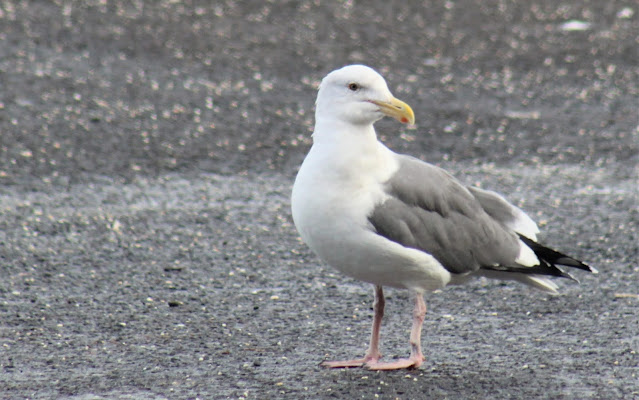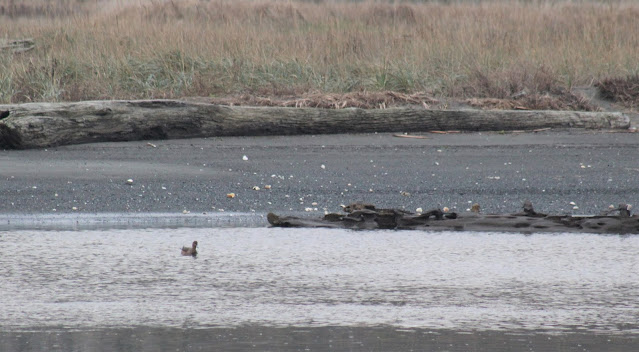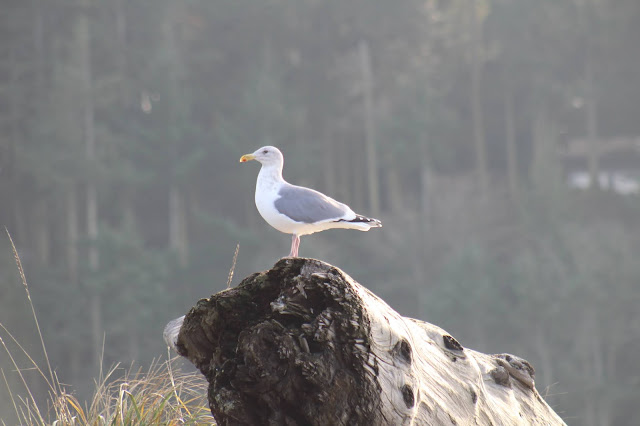It was cloudy and calm and 45º when we got up this morning. I made coffees, wished Marty a Happy Birthday, and saw her off to work. Then, after finishing a bowl of cold cereal, I drove up the Canal to Sequim, where I wanted to see if I could find the Emperor Goose that’d been seen in the Dungeness Bay area.
I’d “dipped” on seeing the adult Emperor at Sauvie’s Island a few days ago, and thought that I might try to find the young bird that's being seen up in Clallam County. The eBird reports of this northern species had been coming in sporadically from all around the Bay, so I arbitrarily decided to start at the Clallam County Park at Cline Spit, where I arrived around 10:30 in the morning. The Park is a little gem that provides a view into the inner part of Dungeness Bay. It’s bordered by private property, and the landowners are adamant about letting park visitors know about that fact.
There are “No Trespassing” signs at the nearby Dungeness Landing County Park, as well. It’s sad that the landowners have had to post their property, likely due to poor behavior by visitors to the public property. The seagulls don’t seem to care. In any event, I could not find the goose from this vantage point.
Being unsuccessful in finding the single member of this species known to humans in the State of Washington, I determined to walk out the long Dungeness Spit and hope for a view from the north side of the bay. On my drive over, I crossed paths with Snohomish County birders Jon Houghton, Blair Bernson and Cindy Bailey, who were also looking for “The Goose”.
Access to Dungeness Spit is through the Dungeness Recreation Area, which is yet another Clallam County Park. Parking is at the north end of the County property, with a half-mile trail access into the Dungeness National Wildlife Refuge through the forest and down to the sand spit.
The Forest Trail arrives at the beach at the west base of Dungeness Spit, a long arm of sand and cobble stretching into the Strait of Juan de Fuca.
The “inside” of the spit is reserved as a sanctuary for birds, leaving the outer beach on the Strait side for the public to walk out as far as they feel comfortable; the lighthouse is 5-½ miles out.
I set up the scope and scanned, seeing a nice flock of Dunlin, mixed with Sanderlings and Black-bellied Plover.
Then, improbably, I saw the goose swimming toward a little point of gravel that was covered with hundreds of shorebirds.
It waded right up onto the cobble beach!
I gave a quick call to Blair, and they rushed out. Sadly, right after I called, a float plane landed and then took off from the Bay, and the goose flushed.
When they arrived at the beach, I met them with the sad news, and we set up our spotting scopes for another look around the Bay.
Again improbably, the goose had returned to land just south of the sand spit, and swam toward us! All of us had great views of this bird.
Washington Bird Records Committee Member Ryan Merrill noted that there were certainly records prior to the “first” in ’99. But the species has been seen much less frequently in recent years, so that it now needs to be documented. This is only the 14th occurrence of Emperor Goose in Washington, since the Committee first added the species to the State’s Checklist in 1999. It is also the first time I’d seen one since the late 1980s, when one spent the winter in the Willamette Valley. Interestingly, the Emperor Goose is not a species that is even on the “Review List” for birders in Oregon!
This is an immature bird, obviously moulting into its “pre-formative”, or adult, plumage. The feathering of the head will become bright white, and the body feathering will turn more ‘solid’, and the bill will turn solid pink.
With success on finding the Goose achieved, Blair et al. and I took our leave of the Dungeness spit. I stopped at the Old Three Crabs site. This used to be a great little tourist stop on the Peninsula back in the day, after the restaurant was built in 1958.
The restaurant and property was sold to the Washington Department of Fish and Wildlife in 2012, who razed the building, pulled the septic tanks, and partnered with local conservation groups to restore the shoreline and estuary. This project improved salmon and steelhead access to valuable estuarine and off-channel habitat by enhancing and stabilizing the connection between Meadowbrook Creek and the mainstem of the Dungeness River. This work was part of the continuing effort to restore the floodplain and estuarine habitat of the lower Dungeness River, and increase available rearing and transitional habitat for salmonids.
There weren’t a lot of birds there when I stopped in the late afternoon, but this is one of the easiest places to see Eurasian Wigeon mixed in the flocks of American Wigeon. Even with only 45 wigeon in attendance, I got a crappy picture of the female Eurasian, which has a russet face, rather than the gray face of the Americans.
It was a great day. The Emperor Goose was the 609th Species I’ve seen this year, and I’m still in contention to finish in the “top ten” of the eBirders in the American Birding Association area. Now, I had to go home and make it up to Marty for my going Bird-watching on her Birthday . . .
Cline Spit eBird checklist is Here
Oyster House eBird checklist is Here
Dungeness Forest Trail eBird checklist is Here
Dungeness Spit eBird checklist is Here
Three Crabs eBird checklist is Here





















No comments:
Post a Comment